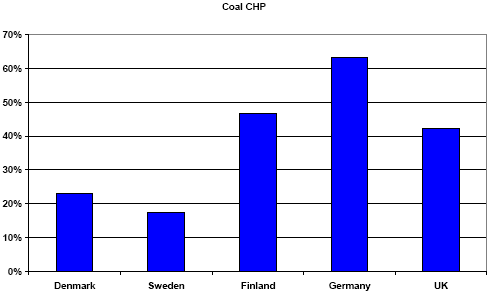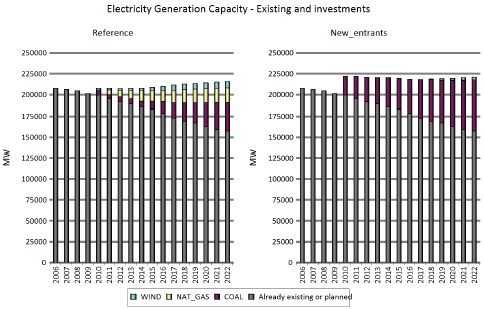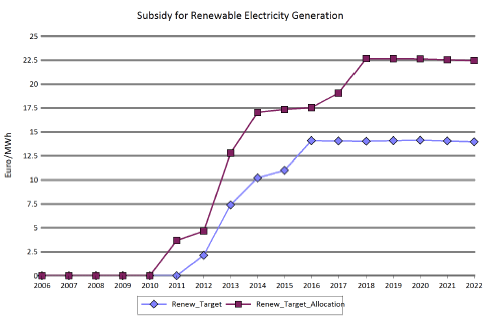Impact of CO2 quota allocation to new entrants in the electricity market
Summary and conclusions
- Allocation to new entrants is an investment subsidy
- Model assumptions
- Impact on investments and CO2-emission
- Economic consequences
- Impacts on the price of CO2 in the EU ETS
- Targets for renewable energy
- Conclusions
In 2003, the EU adopted a directive on a greenhouse gas emissions trading scheme (ETS) encompassing all major energy-producing units and the majority of the energy-intensive industry. The EU ETS is based on the recognition that creating a price for carbon through the establishment of a market for emission reductions provides the most cost-effective way of complying with international greenhouse gas commitments (EU 2005, EU action against climate change).
All countries have opted to allocate CO2-allowances to new power plants. The present project explores the consequences of allocation to new entrants on market players’ investments in the electric market, the welfare-economic consequences and impacts on long-term CO2-emission from the electricity sector.
Allocation to new entrants is an investment subsidy
Allowances for existing and new incumbents are specified in national allocation plans covering EU-defined trading periods. The first period goes from 2005-7, and the second runs synchronously with the Kyoto commitment period from 2008-2012. The national allocation plans are made in accordance with guidelines from the European Commission, but Member States have a high degree of flexibility in their national plans.
In Figure 1, the allocation to a new coal-fired combined heat and power (CHP) plant is compared for five North European EU countries (based on the National Allocation Plans for 2005-7[1]). The EU directive does not require Member States to allocate allowances for free to new entrants, however, all countries have chosen to do so – possibly to attract investments to the power sector, or with the intention to ensure a level playing field between existing plants and new entrants. It appears from Figure 1 that even with a moderate CO2-allowance price of 20 euro/tonne, the income from the sale of allowances is able to cover a considerable part of the total capital costs of a new plant – in Germany more than 60 per cent. This is a substantial investment subsidy.
According to EU rules, only fossil fuel plants may be allocated quotas. This skews investments in the direction of fossil fuel technologies and away from renewable energy, thereby potentially eroding the incentives of the scheme.
Moreover, in some countries such as Germany and Finland, fossil fuel technologies with high emissions (coal power) are allocated relatively more allowances than technologies with low emissions (gas power). This distorts investments in the direction of more polluting fossil fuels, exacerbating the effect on CO2 emissions. Furthermore, subsidies differ substantially between countries; this may skew the geographical distribution of new investments in the electricity sector.

Figure 1: Allocation to new coal-fired plants in selected EU countries. Measured as share of the plants’ total capital costs assuming a CO2-allowance price of 20 euro/tonne, the value of future allowances has been reduced to net present value using a discount rate of 10 per cent over a time scale of 10 years. Based on the National Allocation Plans for 2005-7.
To explore the consequences of new entrant allocation on the power market model, analyses were carried out examining future investments in the German and Nordic electricity and heat markets from 2006-2022. The modelling area represents 30 per cent of EU-25 electricity demand (incl. Norway) and 23 per cent of CO2-emissions from the EU-25 power/heat sector.
Calculations were made using the Balmorel model (see, www.balmorel.com and appendix A), which is a partial equilibrium modelling tool containing detailed information on the electricity transmission system and power/heat plants in the countries covered by the analysis.
Model assumptions
Investments are assumed to take place in a market with perfect competition and no subsidies or other incentives except for the CO2-scheme. Fuel prices in the reference analysis are based on the latest projection by the IEA (World Energy Outlook 2006) and a CO2-price of 20 euro/tonne is applied. Moreover, thermal power plants are expected to be gradually decommissioned at a rate of 3 per cent per annum due to ageing, and nuclear power is assumed to be gradually phased out in Germany.
| Oil price | Gas price | Coal price | CO2-price | Investor rate of return |
| 48 $/bbl | 5.55 $/MBtu | 56 $/tonne | 20 €/ tonne | 11.75% per annum |
Table 1: Key parameters in modelling analyses
Impact on investments and CO2-emission
Under reference conditions – i.e. with CO2-costs of 20 euro/tonne but without allocation to new entrants – new investments are made in a combination of coal, gas and wind power. Over the period 2006-2022, investments in coal power amount to 32,000 MW, investments in gas power technology make up 17,000 MW and wind power 8,000 MW.
When including allocation of CO2-allowances to new power plants, investments are made almost exclusively in coal power. Over the 2006-2022 interval, new coal-power capacity almost doubles compared to the reference. Investments are made in 60,000 MW coal power at the expense of investments in gas power, which declines from 17,000 to 1,000 MW and new wind power, which is reduced from 8,000 MW to 2,000. In total, investments in new power capacity are increased by 6,000 MW because the new entrant allocation works as an investment subsidy.

Figure 2: Investments in new capacity with allocation to new entrants and without allocation to new entrants (Reference). Due to the long lead time of new power plants, the model is only allowed to invest from 2010.
Due to the favourable allocation principles for new power plants in Germany, investments here increase by almost 10,000 MW in the case with new entrant allocation, whereas investments in the Nordic countries are reduced.
The nuclear phase-out and slightly increasing electricity demand lead to a rise in total CO2 emissions, both in the reference case and in the situation with allocation to new entrants. The increase is most profound in the case with allocation owing to the move from gas and wind to coal power. In total, annual emissions are approx. 40 Mt higher in 2022 with new entrant allocation.
For comparison, the model shows that the total savings induced by the EU emissions trading scheme are app. 100 Mt in 2022 assuming a CO2-price of 20 euro/tonne (see Figure 3).
Figure 3: Development in CO2-emissions from Germany and the Nordic countries, 2006-2022. Three developments are examined: 1) Scheme with no allocation to new entrants (Reference), 2) with no CO2-scheme and 3) with allocation to new entrants.
Economic consequences
Though allocation to new entrants does not directly affect the dispatching of power plants in the electricity spot market, the investments in new-generation plants do affect long-term price levels. The additional capacity applied in the simulation with new entrant allocation reduces the number of hours where expensive peak-load facilities need to be in operation.
This effect is most evident in Germany, where the largest number of additional investments is undertaken. Here electricity prices decline from a level of almost 50 euro/MWh to 40 euro/MWh, driving down the profits of existing electricity producers. Consumers, on the other hand, will benefit from new entrant allocation because of the lower electricity prices.
The model is capable of assessing the economic consequences for relevant groups of players, including electricity consumers, electricity producers and grid owners (congestion rents). The entire welfare-economic consequence of measures equals the sum of the consequences for the individual groups (see Table 2).
For the modelling area as a whole allocation to new entrants leads to a welfare-economic loss of €4.1 bn, when reduced to 2006 (net present value). This corresponds to approximately 25 per cent of the total investments in the electricity sector over the period 2006-2022.
| MILLION EURO | DENMARK | FINLAND | GERMANY | NORWAY | SWEDEN | TOTAL |
| Producer | -1,003 | -1,218 | -33,262 | -2,385 | -2,712 | -40,579 |
| Consumers | 954 | 1,387 | 29,535 | 2,510 | 2,995 | 37,381 |
| Grid owners | -72 | -151 | -249 | -43 | -398 | -915 |
| Total | -121 | 18 | -3,976 | 82 | -115 | -4,112 |
| Allocation to new entrants | 282.5 | 195.4 | 18,970.4 | 0.7 | 115.6 | 19,564.6 |
Table 2: Welfare-economic losses and gains distributed on stakeholders. Assumed CO2-price: 20 euro/tonne. Allocations to new entrants are assumed to be deducted from available allocations to producers in general. Therefore free allocations to new entrants do not generate additional revenue for the group as a whole. For comparison, the table also shows the value of the CO2 emission quotas allocated to new entrants.
The losses rise with the CO2-price as the market distortion is proportionate with the value of emissions allowances. At a CO2-price level of 30 euro/tonne the total welfare-economic loss increases to €15.2 bn, whereas a CO2-price of 10 euro/tonne will only lead to a loss of €0.6 bn. The results show that the countries with the highest degree of allocation to new production units incur the greatest losses.
Impacts on the price of CO2 in the EU ETS
Free allocation to new entrants effectively increases the price of CO2 in a capped system because fossil fuel technologies become cheaper for investors. Therefore, a higher CO2-price is needed to stimulate investments in technologies with low or no CO2-emissions. Simulations have been made where CO2-emissions are capped at current levels, and the consequent CO2-price is deduced.
The results show that when including new entrant allocation CO2-prices rise to a level above 40 euro/ tonne where the reduced price of allocations to new entrant exceeds the investment costs of a new power plants. Therefore the model chooses to generate an excessive number of new fossil-fuel power plants.
This signals a threat to the functioning of the EU ETS. It should be mentioned, however, that the simulation does not take into account that quotas can be acquired from other sectors and from JI/CDM projects. This may contribute to keeping down the price of carbon.
If we compare the reference scenario with a CO2-price of 20 euro/tonne and no allocation to new entrants with a situation with a CO2-price of 25 euro/tonne and allocation to new entrants the total welfare-economic loss in the modelling area increases dramatically from €4.1bn to €25.8bn. If new entrant allocation causes the CO2 price to rise further to 30 euro/tonne, the loss rises to €46.2bn and at 35 euro/tonne to €67.6bn.
This shows that the possible welfare-economic losses may become significantly higher than €4.1bn if new entrant allocation affects the CO2-price as the simulations indicate.
Targets for renewable energy
At the meeting of the EU heads of state and government in Brussels on 8-9 March 2007, European leaders agreed to a legally binding objective to meet 20 per cent of their energy needs with renewables by 2020. Although the précis manifestation of these objectives is still very unclear, it is an important step, and in the context of this study, there is an obvious connection.
Additional simulations have been undertaken to assess how free allocations to new entrant interact with a target for penetration of renewables in the electricity generation mix.
The target percentage for renewable generation is introduced from 2010 at a level of 30 per cent - corresponding roughly to the renewable energy ratio in the modelling area in 2010 if no new measures are taken. This target is subsequently increased by 1 percentage-point per year to reach 42 per cent in 2022. It has not been possible to examine how this target fits with the EU objective of 20 per cent renewable energy in 2020 (gross energy) as the EU target has not been distributed on Member States or sectors.
Because of the subsidy to fossil-fuel fired plants, through the allocation of free quotas to new plants, the subsidy for renewable energy plants would also have to be increased to ensure compliance with the renewable target. In 2022, the required renewable subsidy is almost 60 per cent higher in the case with allocation to new entrants, rising from 14 euro/MWh without allocation to 22.5 euro/MWh (see Figure 4).

Figure 4: The necessary subsidy for the marginal renewable generation with and without allocation to new entrants. The subsidy could also be interpreted as the expected costs of green certificates if a Green Certificate market were established. The renewable energy target is introduced in 2010.
Conclusions
The present study shows that allocation to new entrants will have the following long-term consequences if the allocation principles from the 2005-7 National Allocation Plans are continued:
- Investments in new capacity will shift from gas power and renewables to coal power, increasing CO2-emissions by 40 million tonnes/year in the long term (a 6 per cent increase)
- Investments primarily take place in Germany, because allocation here is more generous than in the Nordic countries
- Electricity prices will decrease– particularly in Germany – because allocation to new entrant will stimulate investments in new power capacity with low short-term marginal costs. Consumers will benefit from this whereas existing electricity producers will lose
- Distortions in the market will lead to a welfare-economic loss of almost €5 billion (net present value) at a CO2-price of 20 euro/tonne. The welfare-economic loss increases with increasing quota prices. This is approximately 25 per cent of investments in the electricity sector in the period 2006-2022. Scaled up to the EU-25 level, this corresponds to a welfare-economic loss of €20 billion if we assume that the loss is directly proportionate to CO2-emissions.
- Carbon prices will rise, and hence excacerbate the welfare-economic loss mentioned above. If carbon prices reach 40 euro/tonne, this may endanger the functioning of the EU ETS as the subsidy for fossil-fuel plants will exceed the investment costs of new power plants.
- The costs of achieving a renewable energy target may be increased significantly due to new entrant allocation. According to the simulations by almost 60 per cent from app. 14 euro/MWh in a situation without new entrant allocation to 22.5 euro/MWh.
The European Commission has recently decided to set up a multi-stakeholder working group reviewing the EU emissions trading scheme. The working group will submit a report by June 2007. We hope that the conclusions from this study will be taken into account in this work.
Footnotes
[1] We use the NAPs for 2005-7 since EU decisions are not available for all NAPs for 2008-2012. Changes in allocation principles from NAP I to NAP II are not expected to affect the main conclusions of this study.
Version 1.0 June 2007, © Danish Environmental Protection Agency